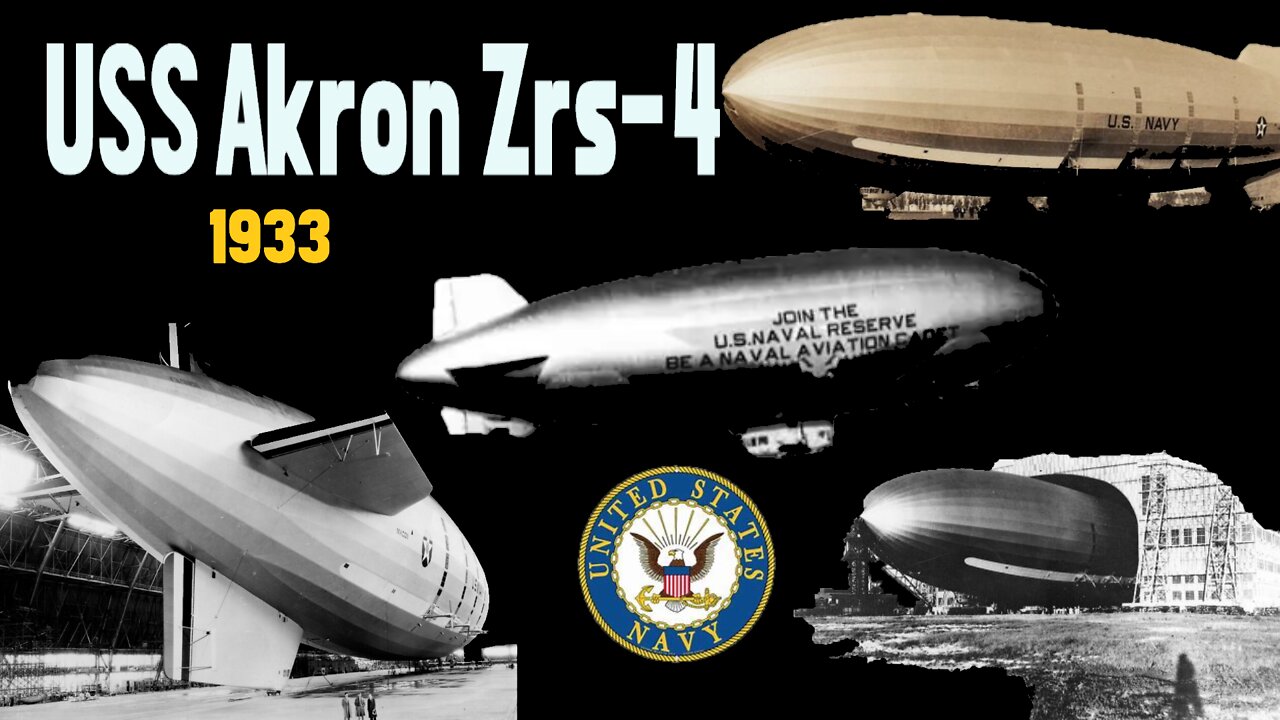Premium Only Content

USS Akron (ZRS-4)
We are a Public Domain sharing community,with a focus on American life pre-1970's..
These videos are for Historic and Cultural preservation.See something interesting?
We encourage viewers to add comments and, especially, to provide additional
information about our videos by adding a comment!
USS Akron (ZRS-4) was a helium-filled rigid airship of the U.S. Navy, the lead ship of her class, which operated between September 1931 and April 1933. It was the world's first purpose-built flying aircraft carrier, carrying F9C Sparrowhawk fighter planes, which could be launched and recovered while it was in flight. With an overall length of 785 ft (239 m), Akron and her sister ship Macon were among the largest flying objects ever built. Although LZ 129 Hindenburg and LZ 130 Graf Zeppelin II were some 18 ft (5.5 m) longer and slightly more voluminous, the two German airships were filled with hydrogen, and so the two US Navy craft still hold the world record for the largest helium-filled airships.[2]
Akron was destroyed in a thunderstorm off the coast of New Jersey on the morning of 4 April 1933, killing 73 of the 76 crewmen and passengers. The accident involved the greatest loss of life in any airship crash.
On the evening of 3 April 1933, Akron cast off from the mooring mast to operate along the coast of New England, assisting in the calibration of radio direction finder stations. Rear Admiral Moffett was again on board along with his aide, Commander Henry Barton Cecil, Commander Fred T. Berry, the commanding officer of NAS Lakehurst, and Lieutenant Colonel Alfred F. Masury, U.S. Army Reserve, a guest of the admiral, the vice-president of Mack Trucks, and a strong proponent of the potential civilian uses of rigid airships.[6]: 77–78
After casting off at 19:28, Akron soon encountered fog and then severe weather, which did not improve when the airship passed over Barnegat Light, New Jersey,[33] at 22:00. According to Richard Smith, "Unknown to the men on board the Akron, they were flying ahead of one of the most violent stormfronts to sweep the North Atlantic States in ten years. It would soon envelop them." Enveloped in fog, increased lightning and heavy rain, it became extremely turbulent at 00:15. The Akron began a rapid nose-down descent, reaching 1100 feet while still falling. Ballast was dumped, which stabilized the ship at 700 feet, and climbed back to 1600 feet cruising altitude. Then a second violent descent sent the Akron downwards at 14 feet per second. "Landing stations" alerted the crew, as the ship descended tail-down. The lower fin struck the sea, water entered the fin, and the stern was dragged under. The engines pulled the ship into a nose-high attitude, then the Akron stalled, and crashed into the sea.[6]: 78–80
The cruiser USS Portland was one of several ships that searched for survivors from the Akron
Akron broke up rapidly and sank in the stormy Atlantic. The crew of the nearby German merchant ship Phoebus saw lights descending toward the ocean at about 00:23 and altered course to starboard to investigate, with her captain believing that he was witnessing an airplane crash. At 00:55, executive officer Lieutenant Commander Herbert V. Wiley was pulled from the water while the ship's boat picked up three more men: Chief Radioman Robert W. Copeland, Boatswain's Mate Second Class Richard E. Deal, and Aviation Metalsmith Second Class Moody E. Erwin. Despite artificial respiration, Copeland never regained consciousness, and he died aboard Phoebus.[6]: 80 Although the German sailors spotted four or five other men in the water, they did not know their ship had chanced upon the crash of Akron until Lt. Commander Wiley regained consciousness half an hour after being rescued. The crew of Phoebus combed the ocean in boats for over five hours in a fruitless search for more survivors. The Navy blimp J-3—sent out to join the search—also crashed, with the loss of two men.[34]
The U.S. Coast Guard cutter Tucker—the first American vessel on the scene—arrived at 06:00, taking the airship's survivors and the body of Copeland on board. Among the other ships combing the area for survivors were the heavy cruiser Portland, the destroyer Cole, the Coast Guard cutter Mojave, and the Coast Guard destroyers McDougal and Hunt, as well as two Coast Guard aircraft. The fishing vessel Grace F from Gloucester, Massachusetts, also assisted in the search, using her seining gear in an effort to recover bodies.[35] Most casualties had been caused by drowning and hypothermia, since the crew had not been issued life jackets, and there had not been time to deploy the single life raft. The accident left 73 dead, and only three survivors. Wiley, standing next to the two other survivors, gave a brief account on 6 April.
American Media Ephemera
Truth Social
@AmericanMediaEphemera
#ephemera, #educational, #culture,#knowledge, #news
#lifestyle,#christianfamily, #nuclearfamily, #truth
#socialguidance, #Religion, #conservative, #rights
#Republican, #DIY, #elections,#makesocialmediafunagain
-
 LIVE
LIVE
Liz Wheeler
43 minutes agoFor Charlie Kirk
582 watching -
 2:52:05
2:52:05
Steven Crowder
5 hours agoFOR CHARLIE KIRK: Breaking Exclusive On Assassin
1.01M1.68K -
 1:19:03
1:19:03
Timcast
3 hours ago🚨CONFIRMED: Charlie Kirk Killer Was Trans Antifa Leftist | Tim Pool
240K404 -
 2:28:45
2:28:45
Benny Johnson
4 hours agoAmerican Martyr: Remembering Charlie Kirk | FBI Reveals New Footage of Assassin, Trump's Eulogy LIVE
217K209 -
 25:38
25:38
The Rubin Report
4 hours agoRemembering Charlie Kirk & 9/11
251K46 -
 1:00:32
1:00:32
VINCE
5 hours agoRest In Peace Charlie Kirk | Episode 123 - 09/11/25
379K363 -
 LIVE
LIVE
LFA TV
8 hours agoLFA TV ALL DAY STREAM - THURSDAY 9/11/25
3,683 watching -
 LIVE
LIVE
Bannons War Room
6 months agoWarRoom Live
7,183 watching -
 25:21
25:21
The Shannon Joy Show
3 hours agoA message of encouragement and a call for faith and unity after the tragic killing of Charlie Kirk
65.3K14 -
 1:31:37
1:31:37
The Big Mig™
4 hours agoIn Honor Of Charlie Kirk, Rest In Peace 🙏🏻
54K18